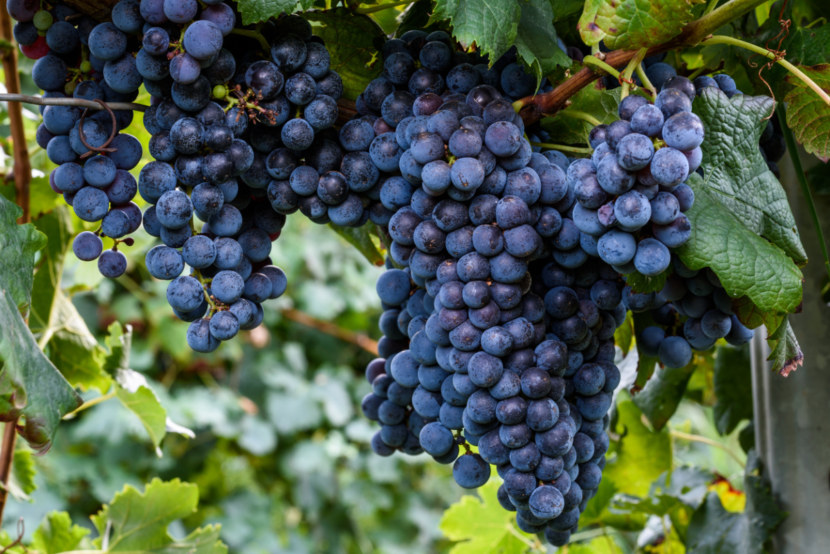
Depending on the variety, grapes may have berries of blue, red, pink, green, milky white, gray, brown. When choosing a variety for cultivation, color has not only aesthetic, but also practical significance: their useful qualities and taste characteristics, due to differences in chemical composition, depend on the color of the fruits.
Content
Features of blue grape varieties
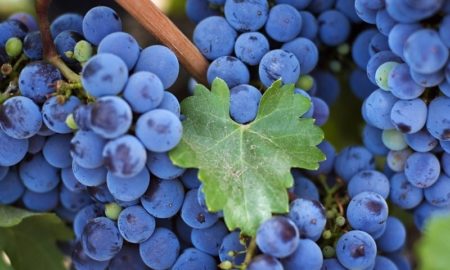
Varieties of blue grapes in color of berries are close to wild varieties of culture, the fruits of which can be dark blue, dark purple, almost black. All other fruit color options appeared due to human efforts.
In most cases, a blue tint is inherent only in the skin of the fruit, for the pulp, as well as for the juice, transparency is characteristic. The color determines the concentration and nature of the location in the tissues of the skin of such substances as:
- chlorophyll, carotene, xanthophyll (antoxanthines);
- quercetin, quercetin (flavones);
- anthocyanin pigments.
Varietal features of blue grapes are associated with the taste, food and medical properties of the product, while differences in plant agricultural technology are rarely due to the color of the berries.
Specifics of care
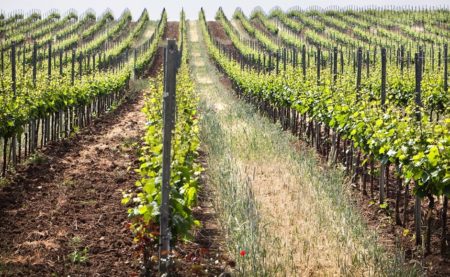
Varieties with dark fruits can have different ripening dates, purpose, yield level, resistance - these indicators determine the basic needs of the plant. But blue-grape grapes also have specific requirements for agricultural technology:
- It should not be allowed to ripen the crop in direct sunlight, dimmed light is more useful. In view of this, thinning leaves to minimize air circulation on the bush requires a minimum, otherwise the berries will be faded, unevenly colored, they may get sunburn.
- It is necessary to ensure sufficient saturation of the plant with potassium and magnesium. With a deficiency of substances, the ripening of fruits of a dark shade occurs with a delay, the color is less saturated.
Beneficial features
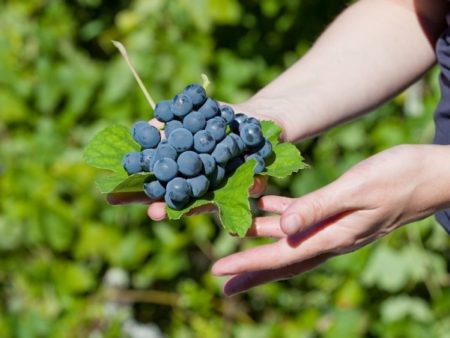
The berries of blue grapes contain many valuable substances for human health:
- vitamins C, E, PP, as well as all vitamins of group B with the exception of B7 and B12;
- antioxidants - beta-carotene, resveratrol, glutathione, melatonin and others (about 300 compounds in total);
- organic acids - tartaric, succinic, oxalic, glycolic, malic, gallic, citric, tartaric, salicylic and others;
- bioflavonoids - proanthocyanidins, quercetin, quercetin;
- phytosterols;
- tannins;
- minerals - iron, calcium, potassium, magnesium, phosphorus, zinc, copper, iodine, boron, cobalt, sulfur and molybdenum.
In general, all types of grapes have a similar chemical composition, but, depending on the color of the berries, they may contain a greater or lesser concentration of individual substances, which determines the degree of usefulness of the product for diseases. Medicine confirms the beneficial effects of dark grapes on such aspects of human health
| Effect on the body | Useful substance |
| Strengthening the heart muscle. | Resveratrol, copper, potassium. |
| Increased vascular elasticity, normalization of blood pressure. | Bioflavonoids, copper. |
| Lowering cholesterol, preventing blood clots. | Antioxidants. |
| Strengthening the immune system. | Vitamins, antioxidants. |
| Stimulation of the intestines (laxative). | Organic acids, fiber. |
| Activation of hemoglobin production. | Iron. |
| Increased resistance of the mucous membranes to damage by bacteria and viruses. | Tannins. |
| Stimulating brain activity, improving memory, increasing stress resistance, preventing senile dementia and Alzheimer's disease. |
Bioflavonoids, copper, phosphorus.
|
| Reducing the risk of tumor formation. | Antioxidants. |
| Prevention of thyroid disease. | Iodine. |
| Normalization of hormonal balance in women. | Boron. |
| Excretion of radioactive substances. | Pectin substances. |
| Extension of youthful skin. | Bioflavonoids. |
It is worth abandoning the use of goodies to people suffering from diabetes, liver disease, pancreas, stomach, intestines, and a tendency to diarrhea.
Advantages and disadvantages of blue varieties
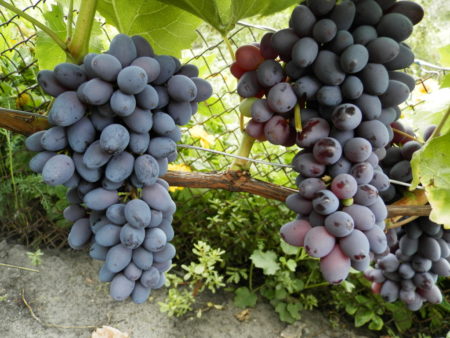
The choice of grapes of a particular shade is a matter of taste, but in dark varieties in comparison with others you can find objective advantages and disadvantages. The first should include:
- The largest proportion of substances beneficial to the cardiovascular system.
- A lower glycemic index than light fruits is 44-54 versus 44-58, therefore, a lower increase in blood sugar when consumed.
- The presence of a wax coating on the skin, which can also occur in some representatives of light varieties. A layer of spring creates additional protection against bacteria, mechanical damage, and the negative effects of weather. Due to this, the keeping quality of the fruits and the resistance to transportation are, on average, higher.
- Attractive appearance of dark blue berries, which makes them a sought-after product.
- Blue varieties can be used to make both red and white wines, while light varieties are suitable only for the production of a white drink.
- The vine with bunches of black has the most decorative appearance, which allows the use of bushes for decoration of arbors or hedges.
Among the shortcomings should be noted:
- Calorie content is higher than that of white fruits - 69 kcal / 100 g and 43 kcal / 100 g. Strictly speaking, in both cases the indicator is considered average, for comparison - green peas has an energy value of 70 kcal, but for people suffering from excess weight, this difference may be significant.
- The negative effect of the product on tooth enamel, manifested in its darkening.
- Dark fruits are more likely to cause allergies than white or pink ones.
- The need for additional care measures at the time of harvest maturation.
Grape varieties with photos and descriptions
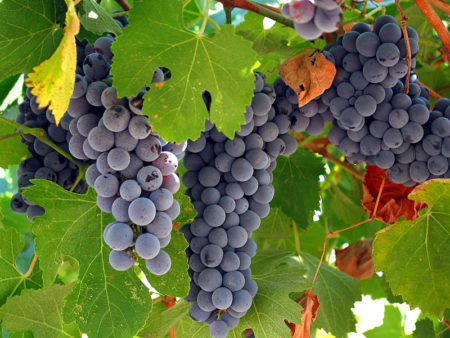
When choosing a variety with blue berries, you need to consider all the usual parameters:
- productivity;
- appointment - dining room, technical or universal;
- fruit parameters (for canteens) - sweetness, taste, number of seeds, peel stiffness;
- technical indicators (for wine) - the return of juice, sugar content and acidity, the presence of aftertaste, a bouquet;
- ripening period;
- growing conditions - resistance to frost, drought, specific requirements for agricultural technology.
Harvest varieties
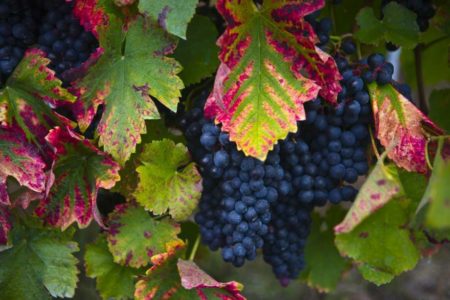
When choosing, it is necessary to find out not only the volume of fruits that the bush gives, but also the mass of berries per square or hundredth of the planting. Vigorous grapes take up a lot of space and with a seemingly large crop, it may turn out to be unprofitable, especially in a small area.
Among the blue varieties there are real champions for crop weight and fruit size:
| Grade | Harvest, ripening period (days) | Features of the structure of the bush | Fruit characterization | Advantages and disadvantages of the variety |
| Strashinsky |
2.5 kg / m2 135-145 |
Large 0.6-1.7 kg weighing clusters have the shape of an elongated cone or cylinder, can be either dense or loose. | Fruits of a round form, 6-12 g, contain 19-20% of sugars and 8.5 g / l of acids. Dining destination. |
The ability to tolerate lower temperatures to -23 ° C. Not susceptible to attack by phylloxera and spider mites. Susceptibility to fungi. Fruits do not tolerate long transport. |
| Jisper Jigsaw |
2-2.4 kg / m2 110-125 |
Conical bunches, on average, 0.4-0.5 kg, can reach 0.8 kg. | The berries are spherical in shape, slightly flattened, medium-sized (4-5 g). Appointment table. The taste is sweet with a nutmeg flavor. |
Winter hardiness can withstand up to -30 ° C. The lack of seeds in the fruit. |
| Baron Black or Enthusiasm Black |
2 kg / m2 115-125 |
Overgrown. Bunches of conical shape can be dense or loose. On average, 500-700 g, there are 1-1.2 kg. | The fruits are round. Sugar content - 17.5%. The peel is covered with a spring. |
Tolerance to frost to -25 ° C. Resistance to powdery mildew, does not apply to other diseases. It requires a lot of space, whimsical care. |
| Nadezhda Azos |
1.6 kg / m2 120-130 |
Berries fill the bunch loosely. The weight of each cluster is not less than 0.7 kg, can reach 2-3 kg. | The fruits are oval, 8-10 g, crunch when biting. The volume of sugars is up to 17%, acids - 7 g / l. The taste is sweet. | It tolerates frosts up to -22 ° C. |
| Muromets |
1.3-1.6 kg / m2 105-110 |
Overgrown. The clusters are conical, medium density. Weight - 0.5-1.1 kg. | Spherical berries, 4-6 g, with a touch. Sugar - 17-19%, acidity - 6-7 g / l. The taste has a nutmeg aftertaste. | It is not afraid of frosts to -26 ° C. |
| Moldova |
1.5-2 kg / m2 160-170 |
The conical clusters have a weight of 0.3-0.6 kg. | The berries are elongated, up to 6 g in weight. The peel is thick but not stiff. Sugar content - 16-19%, acid content - 8-10 g / l. The taste is plum note. Universal grade. |
Frost resistance up to -27 ° C. Fruits tolerate transportation well. |
Early blue grape varieties
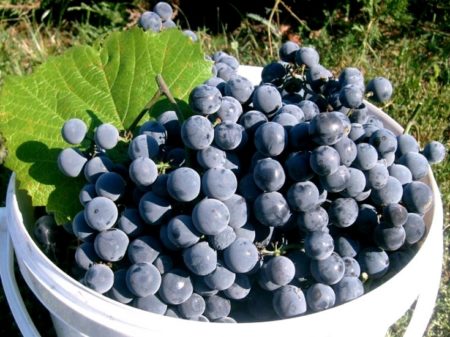
This parameter is especially important in case of cultivation in regions with a short summer, where, as a rule, only early berries have time to fully ripen. In other cases, you can plant plants with different ripening dates to get the product in portions over a long period.
The best among early ripe blue grapes are:
| Grade | Ripening period (days) | Features of the structure of the bush | Fruit characterization | Advantages and disadvantages of the variety |
| Tambovsky | 106-115 | The clusters are dense, 0.5-0.7 kg. | Round berries, large with dense skin. The taste is astringent. Weak aroma. Appointment - dessert. |
Frost-resistant - up to -26 ° C. Medium disease resistance.
|
| Viking | 100-110 | Tall, loose clusters. | Berries are oval, large (8-13 g). Sugar content - 16%, acid content - 5-6 g / l. Dining destination, the taste is pleasant. |
Resistant to frost up to -21 ° C. Not susceptible to disease. The clusters can remain on the bush for a long time, the berries do not crack. Low productivity. |
| Gala | 110-115 | Large clusters - up to 2 kg, on average, 0.6-0.9 kg. | Oval, large (9-14 g) fruits. Sugar content - 16.5%, acidity - 6.8 g / l. Dining destination. |
Resistant to frost up to -21 ° C. The fruits are not peas, they withstand transportation well. Fruits are prone to cracking when overacting, attract wasps. |
| Codryanka | 110-118 | Overgrown. The average weight of a bunch is 0.5 kg. | The berries are oval, weighing from 7 to 16 g. The concentration of sugars is 18-19%, acids - 6-8 g / l. Pleasant taste. |
Hardy to -23 ° C. Clusters can be kept on vines for a long time. The fruits are sometimes peas. There are 1.3 kg of berries per 1 m2. |
| Husayn North | 116-125 | Overgrown. The clusters are loose, 0.5-0.7 kg. | Oval berries, 7-9 g. |
Winter resistance - up to -20 ° C. Pest susceptibility. |
| Byzantium | 120 | Bunches up to 1 kg, conical shape. | The fruits are very dark, turn black when overripe. Round shape, large (12 g). Harmonious taste. Appointment - dining room. |
Frost resistance - up to -24 ° C. Berries can be subjected to long transportation. Pest susceptibility. |
Technical descriptions of blue grape varieties
In most cases, technical berries are not the most delicious fresh - not sweet enough, sometimes tart and with a large number of seeds inside. Berries of wine varieties are usually small in size, like clusters, since this parameter is not significant for the production of drinks.
The best blue grapes for making wine:
| Grade |
Sugar content volume of acids; juice yield |
Features of the structure of the bush | Fruit characterization | Advantages and disadvantages of the variety |
| Saperavi |
17-21,1%; 7.8-12.6 g / l; 80-86% |
The bunch is conic, no more than 0.1 kg. | Small berry (1 g), pleasant taste. |
Resistant to frost up to -20 ° C. Low resistance to powdery mildew, damage by gray rot is possible. Productivity - 9-10 kg per 1 hundredth. |
| Pinot noir |
21,4%; 7.7 g / l; 75,5% |
Clusters are cylindrical, 70-110 g. | Fruits are round, small (1.4 g). Covered with thin skin. |
Fruits are not prone to cracking. Productivity - 0.5-1 kg per 1 m2 of planting. Exposure to phylloxera, insufficient resistance to gray rot, downy mildew. |
| Portuguese |
16-19%; 6-8 g / l; 76,6-79,3% |
Bunches of 250-500 g, elongated, are both loose and dense. | Round berries with thin skin and juicy pulp. | Poor fruit transportability. |
|
Merlot
|
19,5-22%; 5.2-8.5 g / l; 73,5% |
Bunches of 110-150 g, medium density. | The berries are dark blue, covered with a waxy coating. |
It tolerates frosts up to -16 ... -17 ° C. Medium susceptibility to grape aphids and powdery mildew. |
| Cabernet Sauvignon |
17,5-25%; 5.8-11 g / l; 68-72% |
A bunch - 70-80 g, cylindrical. | Berries with an average density of the skin. The pulp is of high juiciness, currant notes in taste. |
Good keeping quality of fruits, possibility of long transportation. Resistance to fungi and gray rot. Immunity above average to defeat leafworm and phylloxera. 500-600 g of berries ripen per 1 m2 of vineyard. |
| Cabernet Franc |
15,6-25%; 6.2-7.2 g / l; 67-70% |
The weight of the bunch is 70-90 g. | In the taste of the fruit there are berry notes (blackberry, raspberry). |
High resistance to fungal diseases and phylloxera. Low productivity - 350-400 g per square planting. |
| Magic |
23,5%; 8.1 g / l; 62-70% |
The cluster is small, loose, conical. | Berries 1.9 g, oval. The taste is rather sour, with a honey flavor. Suitable for the production of sweet wines. |
Frost resistance up to -25 ° C. The bush is quickly restored in case of freezing of the vines. Weak immunity. Productivity - 1.4-1.6 kg per 1 m2. |
|
Mourvedre
|
16-21%; 5-7 g / l; 62-68% |
Overgrown. Bunches can be cylindrical or conical, dense. | Fruits are rounded, less often oval. |
High susceptibility to fungal infection. Good drought tolerance. With a lack of moisture gives a yield of 600 g per 1 m2, but with good irrigation increases significantly. |
A variety of blue-fruit varieties makes it possible to choose an option for every taste and for any purpose - for commerce or private consumption, for making wines, preserves, juice, garden design. Regardless of the size of the plot, region of cultivation, care options, you can find the best grape variety with purple-black berries.

 Non-covering winter-hardy grape varieties for Moscow region
Non-covering winter-hardy grape varieties for Moscow region How to keep the vine in winter
How to keep the vine in winter When can I transfer grapes to another place in the fall
When can I transfer grapes to another place in the fall How to cover and prepare grapes for the winter in the suburbs
How to cover and prepare grapes for the winter in the suburbs